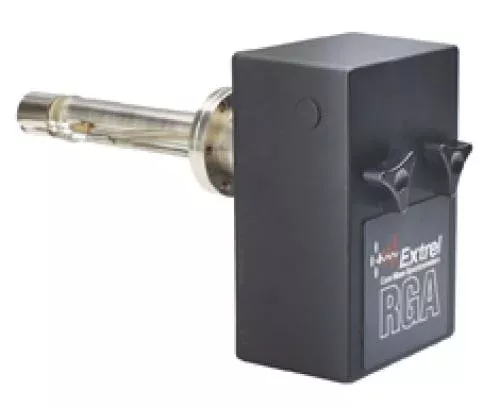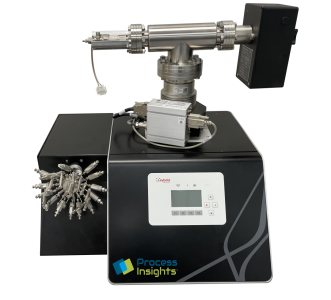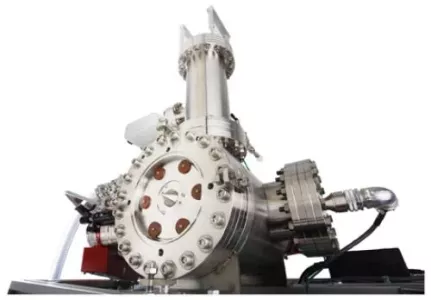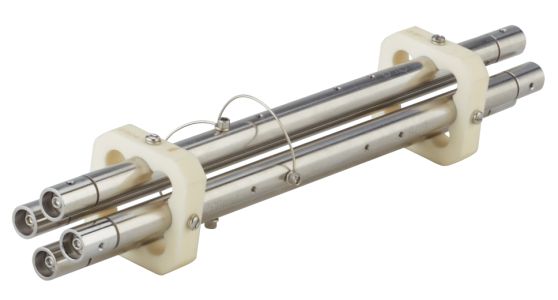RGA
Quadrupole Residual Gas Mass Spectrometer System
UNMATCHED RESIDUAL GAS ANALYZERS
Our EXTREL™ Residual Gas Analyzer RGA™ is a reliable, easy-to-use residual gas analyzer that includes full range pressure measurement. It is the best performing RGA at an affordable price, which makes the system an ideal choice for background gas analysis, leak detection and vacuum chamber characterization. It is available in two (2) mass ranges, 1 to 100 amu or 1 to 300 amu. The system comes standard with a Faraday detector or an optional dual Faraday/Electronic multiplier detector. The Residual Gas Analyzer RGA utilizes RS-232C or USB communication with Windows® XP or 7 operating systems. The software is powerful and easy to use.
BENEFITS
The Residual Gas Analyzer RGA is a highly sensitive and versatile gas analyzer that is commonly used in vacuum systems to measure and analyze the composition of residual gases. Here are some of the benefits of the Residual Gas Analyzer RGA:
- High Sensitivity: Highly sensitive and can detect gases at trace levels. It can detect gases with a mass range of 1 to 300 atomic mass units (amu), making it suitable for a wide range of applications.
- Real-time Monitoring: Provides real-time monitoring of residual gases, which allows for immediate feedback and adjustment of the vacuum system. This is particularly important in high-precision applications where even minor changes in gas composition can have a significant impact on performance.
- Versatility: A versatile instrument that can be used in a wide range of applications, including vacuum processing, semiconductor manufacturing, and materials science. It can also be used to identify leaks in vacuum systems, which can save time and money by reducing downtime.
- Easy to Use: Is easy to use and can be operated by non-experts. It has a user-friendly interface that allows for easy data acquisition and analysis.
- Robust Design: Is designed for reliable and long-lasting performance. It has a rugged and durable construction, and is resistant to shock and vibration.
INDUSTRIES
The Residual Gas Analyzer RGA is a specialized instrument designed for use in a variety of industries that require high sensitivity gas analysis. Some of the common industries that use the RGA include:
- Semiconductor Industry: Used in the semiconductor industry for the analysis of gas purity during the production of microchips and other semiconductor devices.
- Vacuum Technology: Used in vacuum technology for the analysis of gases in vacuum systems and for the detection of leaks in vacuum chambers.
- Analytical Instrumentation: Used in analytical instrumentation for the analysis of gases in mass spectrometry systems and for the calibration of other gas analysis instruments.
- Research and Development: Used in academic and industrial research and development for the study of gas composition in a wide range of applications.
- Aerospace Industry: Used in the aerospace industry for the analysis of the composition of gases in aircraft cabins and in rocket fuel systems.
- Energy Industry: Used in the energy industry for the analysis of gas composition in a variety of applications, including natural gas production and processing.
- Environmental Monitoring: Used in environmental monitoring to measure gas emissions from industrial plants, landfills, and other sources.
Residual Gas Mass Spectrometer

For a complete range of analytical instrumentation, applications, systems, and service options, we will work to match your needs and budget and provide the optimal, and most stable process analysis solution for your application.
SALES | TRAINING INQUIRIES
AMERICAS: info@process-insights.com
EMEAI: info.emeai@process-insights.com
APAC: info.apac@process-insights.com
CHINA: info.cn@process-insights.com
SERVICE | TECHNICAL INQUIRIES
Long-Life Dual Filaments and the Ion Source Kits
Dual thoria-coated filaments are used for electron emission for both the quadrupole and ion gauge operation. The filaments are protected against stress from vacuum excursions by both the ion and the Pirani functions. Our RGA will outlast filaments in conventional RGA units. When a filament eventually does burn out, the second filament will allow for normal operation until filaments are replaced.
Ultra-Sensitive Detection
The RGA units come standard with a Faraday cup detection system. With the Faraday cup alone, the partial pressure measurements from 10-4 and 10-11 torr may be made. With the multiplier option, this sensitivity is extended down to 5 x 10-14 torr. The novel ion current amplifier detects ion currents from 10-6 to 10-15 amps in a single scan. This huge dynamic range allows for very large and very small peaks to coexist on one scan.
Advantages
- Modular compact design for ease of installation and maintenance
- Full pressure measurement with built-in Pirani and BA gauges
- High measurement speed, stability and resolution
- Minimum detectable partial pressure 5 x 10-14 Torr
- 30-minute warm-up time to operation support to multiple heads
- Dual filaments with over-pressure protection
- Programmable electron and ion energy
- Intuitive software with easy-to-use graphic interface
- Choice of computer interface: Serial or USB
- Worldwide on-site and remote support
RGA Vacuum Plus Software
All RGA systems come standard with the Vacuum Plus Real-Time Windows® software package. An intuitive graphical user interface makes the total functionality of the system available to the user. Complete pump-down may be monitored quickly and easily. For further analysis, XML data files (text format) can be saved for transfer into spreadsheets, and graphic images can be saved or copied into other Windows programs.
Powerful Operational Modes
The Vacuum Plus software comes with the operation modes of Analog Sweep mode, Trend mode, Leak Detect mode and Diagnostic Outputs mode. Choices of analog or logarithmic intensity outputs allow the user to zero in on exactly what they want to see. Scale bars further increase the ability of the user to zoom in on their area of interest. Grid line options allow for more exact numerical determinations of peak heights on graphs. Intensity outputs may be set to Torr, Pascal or Ion current.
















